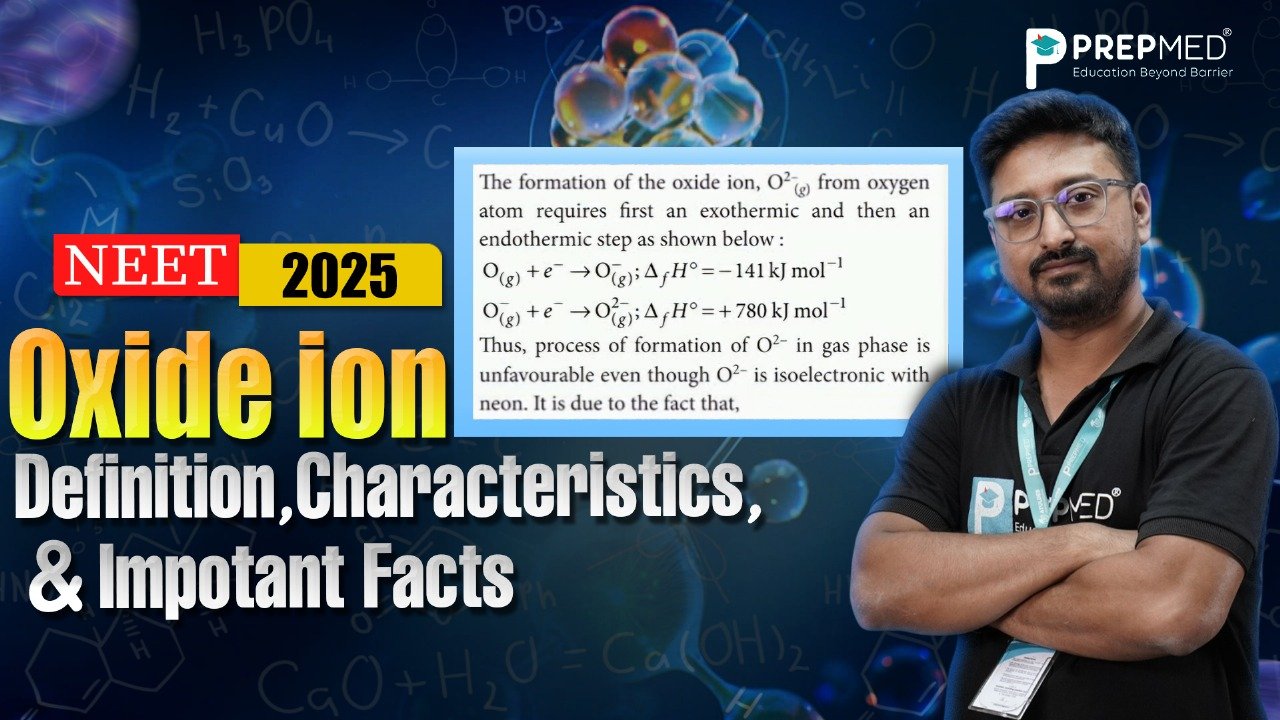April 10, 2025
Oxide Ion: Definition, Characteristics, and Important Facts
The oxide ion serves as the fundamental element that explains why certain compounds exhibit strong reactivity and industrial chemical behavior. The oxide ion is an oxygen atom that has accumulated two additional electrons to produce a 2− negative charge. The powerful oxide ion plays a central role in multiple chemical processes which include metal corrosion together with energy storage and biological functions.
Oxygen gas (O₂) contains two oxygen atoms that we need to survive, but the oxide ion is a single atom with a -2 charge. Nature does not contain oxide ions as free entities because they are highly reactive, so they exist only within compounds such as potassium oxide.
Formation of Oxide Ions
Oxygen atoms transform into an oxide ion because they need additional electrons to reach stability. Oxygen requires two additional electrons to achieve stability because it has six electrons in its outer shell, just like noble gases. During chemical reactions between oxygen and metals like magnesium or potassium, the metal atoms give electrons to the oxygen atom. The reaction process converts oxygen from its neutral state into a negatively charged oxide ion.
The oxide ion example uses magnesium oxide (MgO). Magnesium (Mg) contains two outer shell electrons that oxygen quickly receives from the metal. Mg²⁺ and O²⁻ ions form an ionic compound through bonding. The compound MgO demonstrates an ionic bond with the oxide ion as its perfect representation.
The concept can also be understood through the metaphor of oxygen winning a game of tug-of-war since its electronegative nature causes it to steal electrons from metals. The oxide ion's powerful attraction to electrons makes it highly reactive in numerous chemical reactions.
Chemical Nature of Oxide Ion
Charge and Electronic Configuration
The examination of the oxide ion begins with analysing its electronic structure. Oxygen (O) possesses 8 electrons because its atomic number equals 8. Its electron configuration is 1s² 2s² 2p⁴. The addition of two electrons transforms its configuration to 1s² 2s² 2p⁶, which matches the noble gas pattern of neon. The O²⁻ ion achieves high stability in ionic compounds because its entire outer shell exists while it remains highly reactive during isolation.
This -2 charge is crucial. This ion's double negative charge represents a serious matter rather than a simple single negative charge. The additional electrons make the ion highly reactive, so it readily bonds with positively charged metal ions to create compounds such as copper oxide, and additional metal oxides.
The polyatomic permanganate ion contains manganese and oxygen while differing from oxide ions in structure. The oxide ion represents an essential component for ionic bonds because it remains simpler than the complex permanganate structure.
Oxidation State in Compounds
The oxidation state of oxide ions remains at -2 throughout all compounds. Their chemical identity card remains constant because their value stays the same in every pairing. The reliable behavior of the oxide ion enables scientists to predict its reactions in redox reactions, which form the fundamental basis of chemistry.
The chemical compound NO demonstrates this behavior. The molecule remains neutral and does not act as an ion, while its nitrogen atom has an oxidation state of +2, and the oxygen atom has -2. The oxygen atom demonstrates its versatility through this interaction, although it exists outside the oxide ion form. Actual oxide ions exist only as O²⁻ with a -2 oxidation state in all their chemical forms.
The precise nature of the oxide ion plays an essential role in balancing chemical equations, particularly during combustion and synthesis reactions. Students preparing for NEET entrance tests and other examinations should master the identification and application of oxide ion oxidation states because it represents a fundamental aspect of PrepMed's learning modules.
Types of Oxides and Their Properties
Basic Oxides
Basic oxides function as the resilient members of oxide compounds. Metallic elements that interact with oxygen create compounds which produce salt and water when reacting with acids. A classic example? MgO. When magnesium burns in air, it forms a white powdery compound—MgO—that reacts strongly with acids like hydrochloric acid.
Basic oxides occur naturally in the Group 1 and Group 2 elements which belong to the periodic table. For instance, K₂O is another potent basic oxide that reacts vigorously with water to form a strong base of potassium hydroxide (KOH).
These oxides:
- Have high melting points
- Group 1 oxides are the only base oxides that dissolve in water.
- Basic oxides perform acid neutralisation in standard acid-base chemical reactions.
Basic oxides serve various industrial applications, including industrial desulfurisation, glass manufacturing and cement production.
- Industrial desulfurisation
- Glass manufacturing
- Cement production
Acid reactivity is the fundamental reason basic oxides have become the go-to compounds in neutralisation and refining operations. PrepMed presents the concepts of chemistry modules in a simple fashion, which benefits competitive exam candidates.
Acidic Oxides
Acidic oxides stem from non-metal elements while they combine with bases to generate salts and water. Consider sulphur dioxide (SO₂) and carbon dioxide (CO₂). The water solution transforms these oxides into acidic substances. When SO₂ interacts with water, it becomes the acidic substance H₂SO₃.
SO₂, in particular, is a notable example:
- It is a colorless gas
- Has a pungent smell
- Major contributor to acid rain
While SO₂ contains oxygen atoms, it’s not an oxide ion; the oxygen atoms are part of a molecular compound, not ionic. The expert faculty at PrepMed explains this fundamental difference between students in its educational materials because many fail to recognise it.
Acidic oxides fulfil essential functions that include:
- Fertiliser production
- Industrial synthesis of sulfuric acid
- Environmental discussions on pollution
Amphoteric Oxides
These oxides display a dual nature since they function as acids or bases based on the reaction in which they participate. Amphoteric oxides function as the diplomatic representatives of oxide compounds because they can behave as acidic or basic substances.
The chemical compound Al₂O₃ represents a flawless instance of an amphoteric oxide. The substance demonstrates basic properties in one situation but acts as an acid in another.
Acids trigger salt formation with water when aluminium oxide behaves as a base.
The combination with bases leads to the formation of aluminates, which exhibit acid properties.
Other amphoteric oxides include:
- Zinc oxide (ZnO)
- Lead(II) oxide (PbO)
The metallurgical and electrochemical applications heavily rely on these oxides. Amphoteric oxides possess dual functionality which enables them to perform effectively in catalytic reactions and metal purification procedures.
Neutral Oxides
Neutral oxides are rare birds. These compounds resist both acid-base chemical reactions.
- Nitric oxide (NO)
- Nitrous oxide (N₂O)
- Carbon monoxide (CO)
are considered neutral oxides. Despite oxygen molecules, these compounds do not function as acids or bases. NO, for instance, plays a critical role in biological signaling and is used in medical treatments. But remember—NO is not the same as the oxide ion. The molecule NO exists differently than the ion O²⁻, which carries a full -2 charge.
Neutral oxides often:
- The molecule NO functions as a signalling substance within human bodies.
- These compounds take part in both environmental and combustion reactions.
- Are formed during incomplete combustion
The properties of neutral oxides serve as fundamental elements explaining chemical reactions, atmospheric processes, and physiological functions.
Misconceptions and Clarifications
The oxide ion may sound straightforward, but students often get confused by its behavior and differentiation from other oxygen-containing species. Let’s clear the fog.
- Confusing oxide ions with molecular oxides: The oxide ion frequently gets mistaken for the molecular forms of NO, SO₂ or CO. Such compounds function differently from chemical ions and behave unlike ionic substances.
- Assuming all oxides are basic: Non-metal oxides such as SO₂ exhibit acidic properties instead of fundamental properties. Metallic oxides make up the only group of compounds that contain O2-.
- Thinking all oxygen atoms = oxide ions: Just because a compound contains oxygen doesn’t mean it has oxide ions. The oxygen atoms in permanganate (MnO₄⁻) exist as covalently bonded atoms instead of free ions.
- Incorrect charge assignments: Students often forget that the oxide ion has a -2 charge, which makes balancing chemical equations problematic.
- Missing amphoteric behavior: ZnO and Al₂O₃ exhibit amphoteric behaviour because they show reactivity with acids and bases. These substances cannot be classified as either acidic or basic compounds.
-
Conclusion
The oxide ion is more than just a simple combination of oxygen and electrons. Many chemical processes depend on oxide ions as their fundamental base for reactions that occur across acid-base chemistry, metallurgy, environmental science, and biological systems.
PrepMed is the best platform for competitive exam preparation and understanding basic chemistry. The platform delivers organised educational material that allows effective memorisation, deep comprehension, and practical application.
Also read:
Chemistry tips and Strategies: A perfect 180 in NEET 2025
NEET 2025 Chemistry Chapter Wise Weightage for Guaranteed Success
NEET EXAM 2025 CHEMISTRY WEIGHTAGE: ORGANIC CHEMISTRY AND INORGANIC CHEMISTRY







